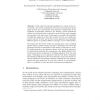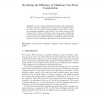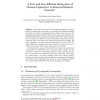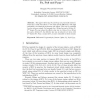115
click to vote
EUROCRYPT
2007
Springer
15 years 4 months ago
2007
Springer
Abstract. With computer networks spreading into a variety of new environments, the need to authenticate and secure communication grows. Many of these new environments have particul...
118
click to vote
EUROCRYPT
2007
Springer
15 years 4 months ago
2007
Springer
Abstract. We introduce a notion of instance-dependent verifiable random functions (InstD-VRFs for short). Informally, an InstD-VRF is, in some sense, a verifiable random function [...
121
Voted
EUROCRYPT
2007
Springer
15 years 4 months ago
2007
Springer
In a recent paper Mohassel and Franklin study the efficiency of secure two-party computation in the presence of malicious behavior. Their aim is to make classical solutions to this...
EUROCRYPT
2007
Springer
15 years 4 months ago
2007
Springer
EUROCRYPT
2007
Springer
15 years 4 months ago
2007
Springer
SFLASH is a signature scheme which belongs to a family of multivariate schemes proposed by Patarin et al. in 1998 [9]. The SFLASH scheme itself has been designed in 2001 [8] and ha...
103
Voted
EUROCRYPT
2007
Springer
15 years 4 months ago
2007
Springer
Essentially all work studying the round complexity of secure computation assumes broadcast as an atomic primitive. Protocols constructed under this assumption tend to have very poo...
116
Voted
EUROCRYPT
2007
Springer
15 years 4 months ago
2007
Springer
We show an efficient secure two-party protocol, based on Yao's construction, which provides security against malicious adversaries. Yao's original protocol is only secur...
96
Voted
EUROCRYPT
2007
Springer
15 years 4 months ago
2007
Springer
Motivated by the quest for reducing assumptions in security proofs in cryptography, this paper is concerned with designing efficient symmetric encryption and authentication schemes...
EUROCRYPT
2007
Springer
15 years 4 months ago
2007
Springer
This paper shows that Py and Pypy are practically insecure. If one key is used with about 216 IVs with special differences, with high probability two identical keystreams will appe...
105
Voted
EUROCRYPT
2007
Springer
15 years 7 months ago
2007
Springer
We study an adaptive variant of oblivious transfer in which a sender has N messages, of which a receiver can adaptively choose to receive k one-after-the-other, in such a way that ...




